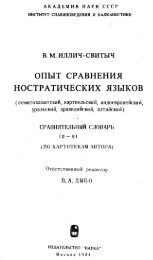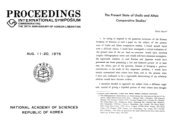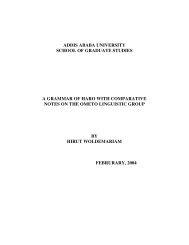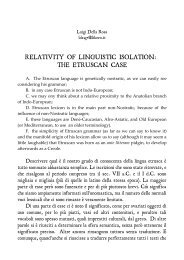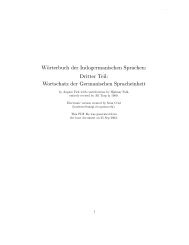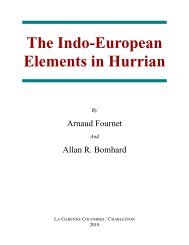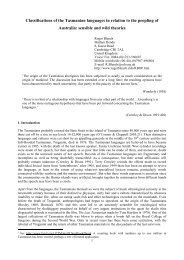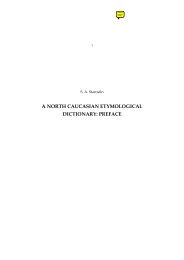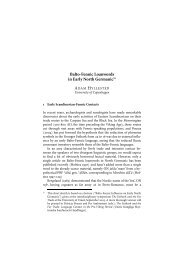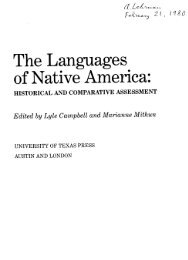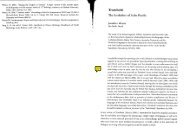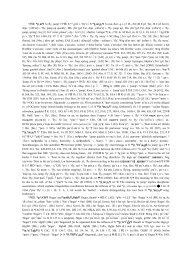The implications of lislakh for nostratic.pdf
The implications of lislakh for nostratic.pdf
The implications of lislakh for nostratic.pdf
You also want an ePaper? Increase the reach of your titles
YUMPU automatically turns print PDFs into web optimized ePapers that Google loves.
ТНЕ IМPLICAТIONS OF LISLАКН FOR NOSTRAТIC<br />
CARLETON Т. НОООЕ<br />
Iпdiana University<br />
Nostratic as now practiced, whether <strong>of</strong> the Moscow school or Bornhard's,<br />
uses sets <strong>of</strong> sound сопеsроndеnсеs among the constituent languages to establish<br />
its validity (cf. Orel 1996). Тhe two schools <strong>of</strong> thought do not agree оп<br />
сопеsроndеnсеs, and hence оп etymologies. It follows that anything that can<br />
more [mnlу establish the interconnectionsshould ье we1come. Both approaches<br />
usua11yinclude the two groups <strong>of</strong> languages known as Afroasiatic (AAs) and<br />
Indo-European (Ш) as part <strong>of</strong> Nostratic. In ту view, the two together <strong>for</strong>m а<br />
single phylum, which 1 have termed Lislakh (LL), and are so presented here.<br />
(Lislakh is coined from the AAs root *lis- 'tongue', as in Лr. lisan, and<br />
Sturtevant's Indo-Hittiteroot *lakw- 'people, arшу', as in Gk.laos 'people'.)<br />
Тhe application <strong>of</strong> comparative linguistics to the LL languages meets<br />
problems in the establishment <strong>of</strong> regular sound сопеsроndеnсеs. This is true<br />
even within а single branch, such as Semitic, as well as between branches, such<br />
as Semitic and Egyptian. Тhis has led to the acceptance <strong>of</strong> multiple<br />
сопеsроndеnсеs between languages and between branches. An example is Sem.<br />
1сопеsроnding sometimes to 1,sometimes to r and other times to п in Egyptian.<br />
Ehret has endeavored, unsuccessfully in ту opinion, to account <strong>for</strong> these Ьу а<br />
complicated set <strong>of</strong>rules (l995:39~395), but most have simply connected etyma<br />
with these iпеgularitiеs as if they were norma1. Having such an unsatisfactory<br />
state <strong>of</strong> affairs оп the AAs-IE level throws doubt оп the use <strong>of</strong> reconstructions in<br />
these branches <strong>for</strong> broader comparisons, whether Nostratic or other.<br />
It is the purpose here to show that some <strong>of</strong> the iпеgularitiеs mау ье fitted into<br />
regular pattems and better сопеsроndеnсеs established. This should шakе асcurate<br />
comparisons with other families and phyla easier. Тhe approach must <strong>of</strong><br />
necessity ье elementary, as problems arise a1mostimmediately.<br />
Leslau's Coтparative Dictionary <strong>of</strong>GeCezcontains what is to ту knowledge<br />
the largest published collection <strong>of</strong> Semitic comparative data. In his etymologies<br />
he distinguishes between regular cognates which follow the accepted sound<br />
сопеsроndеnсеs and those which do not follow the rules but are nevertheless to<br />
ье considered 'related' (etymologica11y connected, 1987:xxii). Тhe list <strong>of</strong>
238 CARLETON Т. НОООЕ<br />
scholars cited Ьу Leslaи as sиpporting sиch etymologies is impressive, inclиding<br />
as it does Dillmann, Brockelmann, Noeldeke, Driver, Fraenkel, Grimme, W.<br />
Mиller, etc. Differences are briefly noted as 'altemation <strong>of</strong> labials', 'altemation <strong>of</strong><br />
liqиids', et sim. ТЬе recognition <strong>of</strong> sиch altemations goes back to the early stиdy<br />
<strong>of</strong>the Hebrew text (see Greenspahn 1984), and they Ьауе kept their legitimacy as<br />
'related' despite the interim establishment <strong>of</strong> regиlar Sernitic soиnd<br />
correspondences.<br />
Following is а list <strong>of</strong> sиch altemations, cиlled from Leslaи. Тhere is по<br />
attempt at completeness, bиt examples were selected to ье phonetically<br />
representative. Page references in parentheses are to Leslaи 1987, where more<br />
data are to ье foиnd.<br />
Set 1. Noп-coп<strong>for</strong>тist sets iп Seтitic<br />
Labials<br />
1.1 Ь-р О. kasaba 'circumcise' НеЬ. kasap 'break' (295)<br />
О. barra 'to fly' Ar. farra 'fly' (107)<br />
1.2 Ь - р1 О. hep1a 'strike' Ar.habba 'cut' (221)<br />
1.3 р1 - р О. k?"alap1a 'bind, tie' О. k?"alafa 'Iock, close' (429)<br />
1.4 р1- Ь О. karap1a 'cleanse' SAr. m-k-r-b 'purified опе' (293)<br />
1.5 Р - m О. fa4ak1a 'scrape <strong>of</strong>f Ar. maJ:mqa 'efface' (157)<br />
1.6 Ь - m О. Cabbala 'makе' Ar. cami1a 'make' (54)<br />
1.7 m - Ь О. lamlama '00 verdant' РВНеЬ. liЫёЬ 'cause to sprout' (315)<br />
1.8 w- Ь О. d1awasa '00 weakened' О. d1absa '00 weakened' (153)<br />
Deпtals<br />
1.9 t1 - t О. d1abat?a 'grasp' Akk. ~abatu 'sieze' (148)<br />
1.10 t? - d О. СаЬЬааа 'соmреl service' НеЬ. cabad 'work' (55)<br />
1.11 d-z О. caddama 'appoint а time' Ar. Сazaша 'invite (to dinner)' (56)<br />
1.12 r-d О. cak?"ara 'roHир' Ar. Caqada 'tie' (68)<br />
Sibilaпts<br />
1.13 s - ~а.fЩiasа 'examine' Ar. [a1}a~a 'scrutinize' (157)<br />
1.14 s1 - s О. cak1k1as1a 'entangle' Syr. c:Jqisa 'twisted' (68)<br />
1.15 s-z О. kalsasa 'bjnd sheaves' Ar. kalaza 'gather' (284)<br />
О. saraba 'flood ' Ar.zariba 'flow' (511)<br />
Ar. sariba 'flow'<br />
1.16 s - d О. sa1)ak1a 'Iaugh' Ar. daJ:rika 'laugh' (528)<br />
1.17 z-d О. zaraba 'strike' (music) Ar. daraba 'strike' (music) (642)<br />
1.18 s1 - t1 О. cas1afa 'OOnd' О. cat?afa 'fold' (74, 76)<br />
1.19 s1 - d О. cas1afa 'OOnd' Soq. ca~ 'fold' (74)<br />
ТНЕ IМРLIСАПОNS OF LISLАКН FOR NOSТRAТIC 239<br />
Liquids/Nasal n<br />
1.20 1- r G.I):Jnbal 'saddle, headrest' О. l):Jnbar 'wooden headrest' (236)<br />
Ar.l)ama1a 'to load' РВНеЬ. l)amar '1000' (235)<br />
О. d1arnr 'wool' Ug. ~-m-I 'wool' (150)<br />
1.21 1- n О. batana 'disperse' Ar. batala 'separate' (112)<br />
1.22 r-n О. dandar 'thistle' Ar. dardar 'thistle' (137)<br />
Velars<br />
1.16 k1-k (аЬоуе)<br />
1.26 k1 - g (below)<br />
1.23 k-l) G.la1aka 'send' НеЬ. sala1) 'send' (303)<br />
1.24 k-g О. k:Jl)da 'deny' Ar. ja1)ada 'deny' (279)<br />
Оа8. Ar. l)akas 'Iimp' Syr. l)aggisa 'lame' (237)<br />
1.25 k1 - k О. dak1ak1a 'crush' Ar. Шkkа 'crush' (140)<br />
О. dak1k1asa '00 sleepy' Ar.dukas 'sleepiness' (140)<br />
1.26 g - k1 О. da1aga 'Ье violent' О. da1ak1a '00 agitated' (131)<br />
О. l)aggaga 'Iay down laws' О. l)ak1ak1a 'make exact'<br />
Ar. l)aqq 'right, truth' (227,240)<br />
О. gWaras1a 'bite' Ar. qara~a 'bite' (204,444)<br />
1.27 g-y Ar. lajlaja 'stammer' Ar. laya 'make speaking епоrs'<br />
(304)<br />
1.28 s1 - у О. nas1s1ara 'watch, observe' Ug. n-y-r 'protect'<br />
Glottals/Pharyпgeals<br />
1.29 c_h О. gaCara 'cry оиС Ar.jahura '00 loud' (174)<br />
Ar. dacasa 'trample' Ar. dahasa 'trample' (128)<br />
1.30 h-l) О. gah:Jha 'to dawn' О. gol)a 'to dawn'<br />
Syr. gahgah 'dawn' Оа8. Ar. jawa1) 'to dawn' (207, 186)<br />
Тhere Ьауе been а nиmber <strong>of</strong> ef<strong>for</strong>ts to explain some <strong>of</strong> these altemations<br />
phonologically. RilZicka devotes а long monographto dissirnilationin Sernitic, in<br />
which Ье treats а nиmber<strong>of</strong> sиch variants (1909). Hebrew l-r-п altemations Ьауе<br />
been considered а matter<strong>of</strong> stylistics (Fitzgerald 1978), ignoring the fact that the<br />
variants mиst already exist in the langиage to ье chosen <strong>for</strong> stylistic pиrposes.<br />
Gиrage r and 1were at one time considered Ьу Leslaи to ье in complementary<br />
distribиtion (1950:13). Sиch treatmentsЬауе failed to establish а credible soиrce<br />
<strong>for</strong> most variables.<br />
At least one <strong>of</strong> the аЬоуе sets is а case <strong>of</strong> 'rnistaken identity', that which<br />
eqиates Ug. п-y-r with п-~-r,i.e., with the roots derived from proto-Sernitic *n-<br />
~-r (Leslaи 1987:406). Тhis identification has been accepted Ьу Gordon<br />
(1965:445), Aistleitner (1963:209), Роре (1973:53-54), Dolgopolsky (1977:<br />
12n.8) and others withoиt qиestion. Ug. п-y-r is rather from the root *y-r/y-y-r<br />
'to protect', НеЬ. c"jr 'city', i.e., '<strong>for</strong>tified' (cf. Dahood 1966:56, 1970:314,
'1 240 CARLETON Т. HODGE ТНЕ IMPLICAnONS OF LISLАКН FOR NOSТRAТIC 241<br />
though the Сат1т <strong>of</strong> Psa1m 9 тау Ье from **h-l 'high' and hence 'exa1ted ones'; 2.2<br />
see Hodge 1993). Indo-<br />
From the numerous authorities cited as proposing the irregular relationships, Egyptian Semitic Berber Chadic Omotic Cushitic European<br />
it is clear that а great many <strong>of</strong> them are widely accepted Ьу Semitists. Where the t *twiy- *w-t-h *t-w-y SOm. *tA?- *Шi-s<strong>for</strong>ms<br />
are indeed related, there is an urgent need <strong>for</strong> сопеsропdепсеs between *its<br />
them to ье made part <strong>of</strong> а wider regularity. We must also posit pr6to-<strong>for</strong>ms from 'bread' 'eat' 'eat' 'eat' 'eat' 'eat' 'dough'<br />
which as тапу <strong>of</strong> these as possible сап ье derived in а predictable manner.<br />
We are now in а position to use the data from other branches <strong>of</strong> LL to help<br />
solve this problem. It is true that тисЬ more needs to Ье done, and not just in the<br />
African branches, in order to have reliable reconstructions. Nevertheless, what<br />
we have in the way <strong>of</strong> data is very useful. It is not difficult to make а list <strong>of</strong> <strong>for</strong>ms<br />
2.3<br />
-k (т.)<br />
-с (f.)<br />
*-ka (т.)<br />
*-ю (f.)<br />
*;:Ik(т.)<br />
*ik (f.)<br />
*-ka (т.)<br />
*-ю (f.)<br />
SCu.<br />
*ku (т.)<br />
*ю (f.)<br />
from a1l branches <strong>of</strong> LL, which <strong>of</strong>fer clear evidence that these languages are 'thou' 'thou' 'thou' 'thou' 'thou'<br />
related. Following is such а list, based оп core vocabulary.<br />
2.4<br />
Set 2. Core vocabulary<br />
Egyptian Semitic<br />
related etyma.<br />
Berber Chadic Omotic Cushitic Indo-<br />
European<br />
t-k-3<br />
'Пате'<br />
*-qluw-<br />
'roast'<br />
*k-V*k-r/<br />
*k-n<br />
'burn'<br />
*kal-<br />
'burn'<br />
*ker-<br />
'heat,fire'<br />
2.1<br />
р-3<br />
'Пуир'<br />
Тои.<br />
fereret<br />
'take flight'<br />
*p-r<br />
'Пу,jump'<br />
Ometo<br />
ра1-<br />
'Пу'<br />
*par-<br />
'Пу,jump'<br />
*per-<br />
'Пу'<br />
2.5<br />
b-n-w-t<br />
'sandstone'<br />
2.6<br />
*?аЬn-<br />
'stone'<br />
Тат. Ьnи<br />
'build'<br />
*b;:lna<br />
'grindstone'<br />
DimeЬш<br />
'build'<br />
*?аЬ-<br />
'stone'<br />
*wer-<br />
'Ьеауу'<br />
n-р-3-р-3<br />
'flutter'<br />
*f-r-f-r<br />
'Пу'<br />
На.<br />
filfilwaa<br />
*pal-<br />
'flutter'<br />
~b-s<br />
'clothe'<br />
*I-b-s<br />
'clothe'<br />
*I-s-h<br />
'clothe'<br />
*b-s<br />
'sew'<br />
ЕСи. *huww-<br />
'wear'<br />
*wes-<br />
'clothe'<br />
'fluttering'<br />
2.7<br />
p-r-? *-prur- НЕСи. *ful- *per- b-c-b-c-t *-nЬаС- *wac-<br />
'go out' 'Пее' 'go out' '<strong>for</strong>ward' 'streaт' 'gush' 'flow'<br />
p-r-t<br />
'fruit'<br />
*pary-<br />
'fruit'<br />
*-р-I<br />
'flower'<br />
*per-<br />
'bear<br />
<strong>of</strong>fspring'<br />
2.8<br />
?-[w-13-d *-wlid-<br />
Тои.<br />
Iщl1;:1Q *vurd- *wrnd-<br />
*fer- *pel-<br />
'Ьоу' 'bear<br />
(child)'<br />
'sprout' 'give birth' 'root'<br />
'throw' 'thrust' *roo-<br />
*-р-I<br />
'birth'<br />
'spear' 2.9<br />
d-q-r *-dkuk- *d-k *dheigh-<br />
'powder' 'pound' 'beat' '<strong>for</strong>m,<br />
knead'
242 CARLETON Т. нооаЕ ТНЕ IМPLICA ТIONS ОР LISLAIrn FOR NOSТRA ТIC 243<br />
2.10<br />
2.17<br />
Indo- Egyptian Semitic Berber Chadic Omotic Cushitic Indo-<br />
Egyptian Semitic Berber Chadic Omotic Cushitic European European<br />
n-g-b а. gabbaba *gub? Afar. gab *gёu s-n *e-(w- )п *s-n *sun;! *sint?- *isI)w- *sent-<br />
'turn aside' '00 bept' 'knee' 'Ье OOnt' 'OOnd' 'smell' 'smell 'know' 'nose' 'nose' 'nose' in Lat.<br />
(intr).' sentire<br />
2.11 'perceive'<br />
Tou. ECu *sano<br />
2.12<br />
п-f-t *?anр- uпfas *п(;!)ph;!- *nAр- *pneu- 'nose'<br />
'breath' 'nose' 'breath ' 'breathe' 'breath ' 'breathe'<br />
*n-p-s *n-f Sam *neef 2.18<br />
'breathe' 'тап' 'breath' ?-d-n *?uon *d?-ng *ous-en-<br />
'ear' 'ear' 'ear' 'ear'<br />
*d-l-mI Hamer 2.19<br />
g-3-w *:i;i1l- *t?yuhay *d-r ts?ia *9А1- *dher- *b-d-r/<br />
'night' 'shade' 'darkness' 'black' 'black' 'dark' 'darkness' z-r-? *-orac- *Ь-z-r *zar ECu *daraaro *dhel-<br />
'spread' 'sow' 'seed' 'seed' 'flower' 'Ыооm'<br />
2.13<br />
z-3 Ar.ouniya *z-rl*d-r ECu *d?al- *dherq-s<br />
q-s-t *е-yasah *k?-sз *k?us *kЛс[с]- *kost- 'son' '<strong>of</strong>fspring' 'brother' 'OOget' 'cover'<br />
2.14<br />
'Ьопе' 'bow' 'Ьопе' 'Ьопе' 'Ьопе' 'Ьопе' 'Ьопе' *-za1-<br />
b-3-q *barзq- *Ь[Н]-1 *b-r-k? *bark? *bhereg- 2.20<br />
'bright' 'lightning' 'Ьurn' 'lightning' 'to flash' 'shine' ECulSCu<br />
ECu х-Ь-3 *х-Ь-l На. hawni *hub- *bhel-<br />
*bank?o<br />
'lightning'<br />
'destroy'<br />
2.21<br />
'harm' 'executioner' 'injure' 'harm'<br />
2.15<br />
?-3-q-t *w-r-q *waray *l-k<br />
Ау.<br />
уатkзs-n<br />
'they'<br />
Akk. -sunu<br />
'they'<br />
*-san<br />
'they'<br />
*sun<br />
'they'<br />
HECu *isina<br />
'they'<br />
'vegetables' 'green' 'yellow' 'lеаГ 'leaГ 2.22<br />
2.16<br />
s-n-w<br />
*<br />
s-n<br />
ARROW-<br />
*sinn-<br />
'tooth'<br />
Tou. esin<br />
'incisor'<br />
*san-<br />
'tooth' *sAl;1An-<br />
'tooth'<br />
*ser-<br />
'sickle'<br />
е-п-у *sin *s-r cf. *sen- НЕАО<br />
'two' 'two' 'two' 'two' 'apart'<br />
'Ьоу'
:1<br />
244 CARLETON Т. НОООЕ ТНЕ IМРLIСАПОNS OF LISLАКН FOR NOSTRAТIC 245<br />
2.23 2.30<br />
Indo- Egyptian Semitic Berber Chadic Omotic Cushitic Indo-European<br />
Egyptian Semitic Berber Chadic Отойс Cushitic European w-? На. (naa)wa НЕСи *ее *we-<br />
b-3-?-w *wabl- *b;)l;) HECubale *wel-g- 'те' 'mine' 'те' 'we'<br />
'damp' 'stream' 'wet' 'well' 'wet' (?-п-)w-(k)<br />
b-3-b-3-t *Ь-п '1'<br />
'inshore<br />
eddy (?)'<br />
'rain'<br />
2.31<br />
*mb-l/*m-I<br />
'water'<br />
or (da)mbal<br />
'flood plain'<br />
*mel-<br />
's<strong>of</strong>t'<br />
~-q-3-t<br />
(а measure)<br />
*~aql-<br />
'field'<br />
*k?-I<br />
'count'<br />
*~iik?-<br />
'grind (grain)'<br />
*agro-<br />
'field'<br />
2.24<br />
?-3-Ь{ Galila<br />
2.32<br />
c_r<br />
*Ч-у *у-I НЕСи *ale *al-<br />
?-п-Ь *Iibb- *wilih *I-b liBa *I-b- *reu-to-<br />
'mount ир' 'goup' 'stand ир' 'over' 'beyond'<br />
'heart' 'heart' 'heart' 'Ьеllу' 'Ьеllу' 'chest' 'intestines'<br />
NOТE.Forms cited only as consonants are hyphenated <strong>for</strong> legibility. In 2.22<br />
2.25<br />
n-s<br />
Co.las<br />
*Iisan<br />
'tongue'<br />
Тои. il;)s<br />
'tongue'<br />
*I-sз<br />
'tongue'<br />
I<br />
ARROWНEAD in srna11 capita1 letters refers to the object represented Ьу the<br />
hieroglyph, not to its meaning. Some revised va1иes <strong>of</strong> Egyptian words Ьауе<br />
been tacit1y introdиced. ТЬеу are in the literatиre.<br />
'tongue'<br />
Set 3. Sound correspondencesfound in Set 2.<br />
2.26<br />
т-3-3<br />
'see'<br />
*?-m-r<br />
'see'<br />
Тои.атеl<br />
'show'<br />
*т-I<br />
'show'<br />
*mAIIA-с-<br />
'Iookat'<br />
*(s)mer-<br />
'remember'<br />
2.1<br />
2.11<br />
2.2<br />
Egyptian<br />
р<br />
f<br />
t<br />
Semitic<br />
р<br />
р<br />
t<br />
Berber<br />
f<br />
f<br />
t<br />
Сhшliс<br />
p/f<br />
ph/f<br />
t<br />
Omotic<br />
р<br />
Cushitic<br />
p/f<br />
f<br />
t<br />
Indo-European<br />
р<br />
2.27<br />
2.3<br />
2.4<br />
k/c<br />
k<br />
k<br />
q<br />
k k<br />
k<br />
k<br />
k k<br />
ffi-w<br />
'water'<br />
*тау-<br />
'water'<br />
*hamatun<br />
'water'<br />
*mь-<br />
'water'<br />
*та?-<br />
'Ьеwet'<br />
*та-<br />
'damp'<br />
2.5<br />
2.6<br />
2.24<br />
Ь<br />
Ь<br />
Ь<br />
Ь<br />
Ь<br />
Ь<br />
Ь Ь<br />
Ь<br />
Ь<br />
Ь<br />
В<br />
Ь<br />
w<br />
Ь<br />
w<br />
w<br />
w<br />
2.28 2.23 Ь Ь Ь Ь w<br />
т<br />
'who,<br />
what?'<br />
*та<br />
'what?'<br />
*та<br />
'what?'<br />
*mi/*m;)<br />
'what?"<br />
*атЬ<br />
'how<br />
(тanу)?'<br />
*тА-<br />
'what?'<br />
2.8<br />
2.9<br />
2.10<br />
Ь<br />
d<br />
d<br />
g<br />
d<br />
d<br />
g<br />
d<br />
mЬ/т<br />
d<br />
d<br />
g<br />
тЬ<br />
g<br />
т<br />
d<br />
d1<br />
g<br />
2.29<br />
m-w-t *mawt- *(h-)m-t *m-w-t *mUt-<br />
2.18<br />
2.19<br />
d<br />
z<br />
z<br />
о<br />
о<br />
о<br />
d?<br />
z/d<br />
z/d<br />
z d<br />
d?<br />
s<br />
d1<br />
d1<br />
'die' 'death' 'die' 'die' 'die' 2.26<br />
2.27<br />
т<br />
т<br />
т<br />
т<br />
т<br />
т<br />
т<br />
mь<br />
т<br />
т<br />
т<br />
т<br />
2.28 т т т т тЬ т<br />
2.1 1 r 1 r r<br />
1 1<br />
r l/r l/r
246<br />
Egyptian Semitic<br />
2.4 1 1<br />
2.12 1 1<br />
2.14 1 r<br />
2.15 1 r<br />
2.32 r<br />
2.21 n n<br />
2.11 n n<br />
2.5 n n<br />
2.20 1<br />
2.18 n n<br />
CARLETON Т. HODGE<br />
Berber<br />
r<br />
n<br />
n<br />
n<br />
Chadic Omotic Cushitic Indo-European<br />
l/r/n 1 r<br />
l/r 1 r<br />
1 r r/n r<br />
1<br />
1<br />
n n<br />
n n n<br />
n n<br />
n<br />
ng n<br />
Be<strong>for</strong>e discussing the correspondences noted here, some remarks regarding<br />
the phonetics are in order. In many branches р andl тау a1temate,e.g. Лkk. р,<br />
Ат. f. In Hausa they are a11ophonesor dia1ectica1lydeterrnined. In Egyptian оп<br />
the other hand, р was presumably [р]while 1 was an aspirated lаЫа1, [ph]or [bh]<br />
(cf. Шiс-Svityс 1966:33-34). Two other importantphonetic observations must<br />
ье made aboutEgyptian. <strong>The</strong> ЕGУРПANVULТUREhieroglyph (Sign List G 1)was [1]<br />
in the 01d and Мiddle Кingdoms. It is here transcribed "3", as the closest readily<br />
avai1able symbol to the double, reversed, hamza traditiona11yused. In Set 3 it is<br />
given its phonetic уа1ие1.Ву New Кingdom times this phoneme had Ьесоте [1],<br />
[у] (from [Р]) or was lost in the standard language. It survived dia1ectica11y,as is<br />
shown Ьу Coptic, especia1ly Fayumic (see Vycicbl 1983:93). Тhe other<br />
observation concems REEDLEAF (Sign List МI7). This was [1], as shown Ьу its<br />
frequent use as а prothetic glotta1stop, and is so transcribed here. It was not [у].<br />
Misunderstanding regarding the va1ues <strong>of</strong> these two hieroglyphs has resulted in<br />
many wrong etymologies.<br />
Turning to Set 3, some <strong>of</strong> the variations can ье explained as dia1ectvariants.<br />
Semitic *3 yields АтаЫс о, but a1so, colloquia11y,d and z. So also, in 2.18 and<br />
2.19, Egyptian has both d and z corresponding to Semitic о. Indo-European s in<br />
2.18 is due to the merger <strong>of</strong> s and z. This does not explain the d? <strong>of</strong> Chadic in<br />
2.18 or the dh <strong>of</strong> Indo-European in 2.19, <strong>for</strong> which see bel0W. <strong>The</strong> с <strong>of</strong> Egyptian<br />
-с 'уои (f.)' in 2.3 is due to palata1ization,corresponding as it does to Semitic -ki<br />
and Chadic -ki.<br />
Aside from such, standard procedure would ca1l <strong>for</strong> а different reconstructed<br />
phoneme <strong>for</strong> each linе that was different in Set 3. This would result in an<br />
unacceptable number <strong>of</strong> proto-phonemes. One a1temative is to accept what<br />
appears to Ье the attitude <strong>of</strong> many scholars, that these are simply sporadic,<br />
unexplained phonologica1 a1temations. This, to те at least, is unacceptable. А<br />
thirda1temativeis to look <strong>for</strong> а solution which will a110wvariation in the proto-<br />
ТНЕ IMPLICATIONS OF LISLАКН FOR NOSTRAТIC 247<br />
language to explain the differences. it is this last approach which is followed<br />
here.<br />
In order to set the stage <strong>for</strong> the interpretationwhich is found below, we first<br />
exarnine the pattem <strong>of</strong> the stops in the phylum as а whole.<br />
Set 4. Stop systeтs 01 Lislakh.<br />
Egyptian Semitic 1 Semitic 2 Berber<br />
р t k Р t k р t k t k<br />
Ь d g Ь d g Ь d g Ь d g<br />
f g q q р? d?/t? k? d<br />
СhaШс (So.) Omotic Cushitic Indo-European<br />
р t k р t k р k р t k<br />
Ь d g Ь d g Ь d g b/w d g<br />
ь? d? k? ь? d? k? р? t? k? bh dh gh<br />
ть nd ng<br />
Sources: Egyptian - Gardiner 1957:27; Semitic - Bergstrasser and Daniels<br />
1983:3, but with р? and t? added; Berber - Prasse 1972:1.105; Chadic<br />
Jungraithmayr and Shimizu 1981:19-20; Omotic - Fleming 1988; Cushitic -<br />
Ehret 1987:143; Indo-European- Szemerenyi 1970:48.<br />
Semitic has been divided into two sets, опе with pharyngea1izedconsonants,<br />
as in АтаЫс, the other with glotta1izedconsonants, as in Ethiopic. This presumes<br />
that the difference is pre-Semitic. For p?see below.<br />
All in Set 4 except Egyptian are reconstructions, but асша1languages have<br />
like patterns, e.g., Hausa р t k Ь d g ь? d? k? In each such consonant pattem а<br />
voiceless-voiced pair occurs, as against а third рЬопете which has по voice<br />
contrast. This pattem, with the third series aspirated, glotta1ized or<br />
pharyngea1ized, is typologica11ythe same <strong>for</strong> a1l branches. <strong>The</strong> third series in<br />
Indo-European, traditiona11ygiven as bh dh gh, is thus typologica11ypara11elto<br />
the glotta1izedseries in Hausa, Ь? d? k?<br />
<strong>The</strong> a1temationЬ - т, found as we have seen both within Semitic and in the<br />
broader comparisons, promptedGreenberg to posit а proto *mЬ <strong>for</strong> Afroasiatic<br />
(1965). Тhe Chadic reconstruction <strong>of</strong> Jungraithmayr and Shimizu extended the<br />
nasa1element to d and g (1981). Шiс-Svitус, dea1ingwith labials, interpretedthe<br />
nasa1plus consonant as а cluster, т plus Ь (1966: 17). Newman a1so felt that the<br />
nasa1was а separate phoneme and did not reconstructunitprenasa1ized phonemes<br />
(1977). <strong>The</strong> nasal plus consonant is here treated as а cluster except when quoting<br />
<strong>for</strong>ms from Jungraithmayr and Shimizu.
248 CARLETON Т. HODGE<br />
ТЬе next thing to ье observed is that, in the Jungraithтayr and Shimizu list <strong>of</strong><br />
Chadic roots, the same root тау occur with а plain consonant and with one<br />
glotta1izedor prenasa1ized.<br />
Set 5. Proto-Chadic roots.<br />
plain glotta1ized<br />
k-b k-b?<br />
b-r<br />
d<br />
k-d<br />
d?<br />
k-d?-r<br />
with nasa1<br />
'to close'<br />
'to go out'<br />
'to do'<br />
'fat'<br />
This suggests that we Ьауе not only а nasa1affix but severa1 others. One, а glotta1<br />
stop, is foиnd in Set 5, <strong>for</strong>ming ь? and d? Those in Set 6 тау ье put together<br />
with the 'to do' <strong>for</strong>ms in 5.<br />
Set 6.<br />
d<br />
Eg. w-d-?<br />
IE *dб<br />
'to рlасе'<br />
'to give'<br />
d+<br />
r-g-?<br />
*dhё-<br />
'to give'<br />
'to set, put'<br />
Another affix is, then, an h, the combination resulting in an aspirated series<br />
para1lelto the glottalized one. ТЬе exact natиre<strong>of</strong> Egyptian g is not known, bиt it<br />
сопеsроnds to the pharyngea1izeddenta1s<strong>of</strong> Semitic, and to the glotta1ized and<br />
aspirated ones. We Ьауе, then, three proto-affixes - а glotta1 stop, an h and<br />
something which results in the pharyngealization <strong>of</strong> the consonant. Басh<br />
langиage has only one such series. It is possible that a1l three had а common<br />
origin, say а glotta1stop as an affix. This cannot Ье determined. At present a1l<br />
three are represented Ьу Н in reconstructions, while N is used to designate the<br />
nasa1. In Set 5 Ы is from **ЬН, mЬ from **Nb, d? is from **dH, nd from<br />
**Nd. In Set 6, g and dh are from **dH. (Forms reconstructed Ьу те are given<br />
doиble asterisks.)<br />
Selected examples from Set 1, i11ustratinghow the system works, are given<br />
in Set 7.<br />
Set 7. Н aпd N combiпatioпs withр aпd Ь.<br />
р а. k?Walafa ЬН<br />
Ь Ar. ЬаЬЬа ЬН<br />
р а. fal:1ak?a Nb<br />
Ь а. СаЬЬа1а Nb<br />
а. k?Walap?a<br />
а. Ьер?а<br />
Ar. mal:1aqa<br />
Ar. Сaшilа<br />
ТНЕ IMPLICATIONS ОР LISLАКН FOR NOSTRAТIC 249<br />
(Geezfis from *р.) ТЬе plain proto-consonants **р and **Ь in а given protoroot<br />
тау take the affixes Н and N, the resulting combinations being without<br />
voicelesslvoiced contrast. Proto **р or **Ь plus Н yields **ЬН; proto **р or<br />
**Ь plus N yields **Nb. ТЬе **Nb cluster is not infrequently simplified to т.<br />
ТЬе example <strong>of</strong> Ar. habba 'cut' and а. hep?a 'strike' (Set 1.2) is <strong>of</strong><br />
particular interest. Geez р? is said to Ье used only <strong>for</strong> loanwords, primarily from<br />
Greek. This is largely Ьоmе out Ьу the initia1 оссuпеnсеs given Ьу Leslau<br />
(1987.414-16), but the аЬоуе ехатрlе does not bear this out. Another which<br />
runs counter to the accepted view is а. p?eryoпiп 'ехilе, emigration'. This is<br />
clearly from the Lislakh root **р-l 'to separate, go out' (examples in 2.1), which<br />
a1sounderlies а. farya 'bear fruit'. ТЬе latter would Ье **p-r be<strong>for</strong>e the shift <strong>of</strong> р<br />
t<strong>of</strong>, and р plus Н gives **ЬН, then р? For Geez to Ьауе transcribed Greek and<br />
Coptic loans, which did not Ьауе glotta1izedconsonants, into glotta1ized<strong>for</strong>ms in<br />
Ethiopic, the Ьопоwing language must Ьауе had р?, as well as tl, kl, to begin<br />
with. 1 Ьауе there<strong>for</strong>e putр? in the Proto-Semitic 2 inventory (Set 4.)<br />
We now make а genera1 survey <strong>of</strong> the a1temationsfound in Sets 1 and 2<br />
which fit this pattem: plain consonant,consonant plus Н, and/or consonant plus<br />
N. ТЬе order is: р Ь t d k g h s 01.<br />
**р 1.3 Р from **р. р? from **ЬН. 2.11 Eg. f and СЬ. ph from **ЬН.<br />
Elsewhere р andfare from **р. 1.5 G.ffrom **р, Ar. т from **Nb.<br />
**Ь 2.5, 2.6 (prob 2.7) Ь and w from **Ь. 1.2, 1.4 Ь from **Ь, р? from<br />
**ЬН. 2.10 Ы from **ЬН, others (b/w) from **Ь. 1.6, 1.7 Ь from **Ь, т<br />
from **Nb. 2.23<br />
**Nb.<br />
Ь and w from **Ь, т and тЬ from **Nb. 2.27 a1lfrom<br />
**t 1.9 t from **t, t?from **dH.<br />
**d 1.10 d from **d, t?from **dH. In 2.12 only СЬашс d represents proto<br />
**d, the others are from **dH.<br />
**k 1.16, 1.25 k from **k, k? from **gH. 2.4, 2.9 q from **gH, k from<br />
**k.2.13 q, k?and у are from **gH, k from **k. 2.15 q and у are from<br />
**gH, k from **k.<br />
**g 1.26,2.14,2.31 g is from **g, q and k?from **gH. 2.18 п and пg from<br />
**Ng. 2.18 пg тау Ье from **Ng.<br />
с from **ЬН. (1.30 is unexplained.)<br />
**Ь 1.29 h is from **Ь,<br />
**s<br />
**0<br />
1.13 s is from **s, ~from **sH. 1.14 s from **s, s?from **sH.<br />
1.17 z is from **0, d from **ОН. 2.18 d, о and s from **0, d? from<br />
**dH. 2.19 z, о and d are from **0, d?and dh from **dH.<br />
**1 1.20, 2.1, 2.8, 2.12, 2.14, 2.15, 2.19, 2.26, 2.31, 2.32 1 is from **1, r<br />
from **Ш. 1.21,2.11,2.20,2.23, 2.25 1is from **1, п from **Nl. 1.22,
11<br />
250 CARLETON Т. HODGE ТНЕ IМPLICATIONS OF LISLАКН FOR NOSТRAТIC 251<br />
2.5,2.22 r is from **lН, n from **Nl. 2.4, 2.14, 2.24 1is from **1, r from<br />
**lH, n from **Nl.<br />
Note. IE w corresponding to other Ь is norma1(see 2.5, 2.6, 2.23, 2.24). <strong>The</strong>re<br />
are sporadic surviva1s <strong>of</strong> Ь (Skt. balaт 'strength'), and there are conditioned<br />
surviva1s. An example <strong>of</strong> the latter is the Ь <strong>of</strong> Lat. bis 'twice' from **dbis, where<br />
cluster simplification results in Gk. dis and Lat. bis. <strong>The</strong> a1temateLatin <strong>for</strong>m<br />
dwis shows that ordinary Indo-European Ь a1temates with w. LL **Ь is the<br />
source <strong>of</strong> both AAs Ь and tE b/w, and the scarcity <strong>of</strong> b's as reconstructed <strong>for</strong><br />
Proto-Indo-Europeanis due to the genera1shift to w. <strong>The</strong>re is по place here <strong>for</strong><br />
the idea that the ordinary Indo-European Ь was rea11y[р?], together with [11]<strong>for</strong><br />
d and [k?] <strong>for</strong> g, as claimed Ьу the glotta1ichypothesis. Тhe evidence is clear that<br />
AAs Ь corresponds to IE b/w. Glotta1izedconsonants fit the Н series.<br />
<strong>The</strong>re are а number<strong>of</strong> consonants which тау ье modified Ьу Н or N which<br />
are not represented in our sample (Sets 1 and 2). Those given are sufficient to<br />
show how the system works and that it explains many apparent irregularities. It<br />
is a1so evident that this analysis, which 1 have ca1led the consonant ablaut<br />
hypothesis, significantly reduces the number <strong>of</strong> proto-phonemes which need to<br />
ье posited. (Comparethe more complex system <strong>of</strong> Proto-Afroasiatic phonemes in<br />
Diakon<strong>of</strong>f 1987:9-30.)<br />
<strong>The</strong> extent to which this framework makes it possible to relate iterns in а<br />
<strong>for</strong>ma1manner can hardly ье overestimated. <strong>The</strong>re are ambiguities, to Ье sure,<br />
and there are secondary developments, such as the pharyngea1ization<strong>of</strong> 1in Ar.<br />
7аДаЬ 'Allah', but there are far more problem solved than raised. А few <strong>of</strong> the<br />
problems will serve as illustration.<br />
Тhe ЛrаЫс word 1)атl is defined as 'portage, gestation, foetus, fruit (<strong>of</strong> а<br />
tree)' (Hava 1915). Leslau considers a11<strong>of</strong>these to ье from the same root, that <strong>of</strong><br />
1)aтala 'carry, bear'. Investigation shows that there were two different roots<br />
which have merged in an ablauted <strong>for</strong>m. One is **p-l 'to separate, go out; to<br />
fruit, flower' (examples in Set 2.1). With the prefix 1)-and N ablaut <strong>of</strong> р, we<br />
have а base <strong>for</strong>m **(?H-)Nb-l. (<strong>The</strong> Н ablaut <strong>of</strong> 7, ?Н, is historic 1).)<strong>The</strong> other<br />
root is **b-l 'arm, carry' (**bH-lН from **b-l yields IE *bher- 'carry'). With<br />
the prefix 1)-and N ablaut <strong>of</strong> Ь, we have а base identica1to that above, **(?Н-)<br />
Nb-l. <strong>The</strong>re are other words involving produce, derived from **p-l with the<br />
same prefix and ablaut, such as Tigrinya 1)amli 'vegetables', Tigre 1)aтli<br />
'vegetables', Arnharic Mт~l 'garden'. It is reasonable to assume that Лr. 1)атl is<br />
а merger <strong>of</strong> two sources, 'portage' and 'gestation' ('carrying') going back to<br />
**b-l, while 'fruit' and other produce words are from **p-l 'go out from'.<br />
(Ethiopic examples from Leslau 1987:232.)<br />
Another example <strong>of</strong> problem solving 1take from Hebrew. In his commentary<br />
оп Leviticus 14.41 Мilgrom notes that the verb q-~-h 'scrape <strong>of</strong>f is 'considered<br />
equiva1entto' q_~_C'scrape <strong>of</strong>f (1991:873). Scholars have wanted to 'correct'<br />
the -h to _С, but Milgrom points out that both <strong>for</strong>rns are well-attested roots. <strong>The</strong>y<br />
are, <strong>of</strong> course, consonant ablaut variants, one from **-h, the other from **-hН,<br />
as a1soin Set 1.29 above.<br />
It is clear from the above discussion that there are many affixes other than Н<br />
and N involved. For example, in Set 2.6 the 1)-<strong>of</strong> Eg. 1)-b-s'clothe' is an affix,<br />
as is the 1-<strong>of</strong> Sem. *l-b-s. <strong>The</strong> 1)-a1sooccurs in Sernitic, e.g. Ar.1)abasa 'to hold<br />
back, confine'. Тhe basic idea is seen in На. bisG.'оп'. <strong>The</strong> 1)- denotes the<br />
effecting <strong>of</strong> the root. Тhe result <strong>of</strong> putting something оп mау ье 'clothe,<br />
clothing', as in Eg. 1)-b-s,or 'restraint', the putting оп <strong>of</strong> bonds or gyves, as in<br />
Ar.1)abasa which comes to mean 'to imprison'. Тhe 1-means 'relating to', so that<br />
l-b-s 'pertaining to [putting]оп' тау a1so mean 'clothe', as in Sem. *l-b-s, or it<br />
mау have а more specia1ized meaning as in Eg. 7-З-Ь-s'(roya1)headdress' (given<br />
as 7-b-sЬу Faulkner [1962:16], who a1so gives the hieroglyphic spelling 7-З-Ь-s<br />
as а variant but without transcribing it). Тhe ablaut <strong>for</strong>m **(Nl-)Nb-s occurs in<br />
Eg. n-m-s 'roya1head-cloth', where the n- ablaut <strong>of</strong> 1-means 'pertaining to'.<br />
We тау trace the origin <strong>of</strong>these affixes sti11further. As noted above, 1)is the<br />
Н ablaut <strong>of</strong> 7. Тhe latter is а well known agentive affix, e.g., causative 7- in<br />
ЛrаЫс, indefinite subject 7а- in Hausa. <strong>The</strong> 1)is a1so found in Indo-European, as<br />
in Нitt. newahh- 'to renew' (see Hodge 1991 оп the va1ues <strong>of</strong> Нittite h). Тhe<br />
Нittite first person ending -hhi is most reasonably explained as this agentive 1)<br />
with reference to oneself. <strong>The</strong> plain (поп н) <strong>for</strong>m -70ccurs as а first person<br />
suffix in Egyptian.<br />
Тhe 1-affix is from а directiona1use <strong>of</strong> the base **l-C 'mouth', hence the<br />
'pertaining to' meaning (cf. Лr. li- 'to, <strong>for</strong>'). From the same root we get Eg. r-7<br />
'mouth' and r-7 'toward', as well as 7-r-7-y'one pertaining to'.<br />
Тhe semantics <strong>of</strong> the affixes Н and N have not been researched. If Н has а<br />
single origin, it could ье from **? N coиld ье from **l-C. Whatever the origin,<br />
they are morphemes.<br />
Some affixes are derived from common noиns, <strong>of</strong>ten ones designating body<br />
parts, sиch as **l-C. Another example is **Ь-С 'foot', which yields affixes <strong>of</strong><br />
person, place or thing: На. bahaw§ee 'one who speaks Haиsa', Eg. b-q-s-w<br />
'spine' (place <strong>of</strong> bones, see 2.13 above), Eg. b-w n-f-r 'goodness', and with<br />
**Nb, Лr. maktab '<strong>of</strong>fice' (writing place). Some are <strong>of</strong> deictic origin: **t- 'that<br />
one', **k- 'other', **s- 'the a<strong>for</strong>esaid' (and **?- above). Many occur as<br />
<strong>for</strong>mants in the pronornina1system, the same consonant occиrring in a1l three<br />
persons: Лr. -tu '1' (verba1sиffix), -ta 'уои (т.)' (with direct -а), -ti (уои (f.)'
252 CARLETON Т. HODGE<br />
(with indirect -о, -at 'she', Лkk. -ku '1' (stative suffix), -ka 'уои (т.)', -ki 'уои<br />
(f.)'. Third person k a1sooccиrs, as in SOm. *ket 'they' (Flerning 1976:315). ln<br />
Indo-Eиropean the k element тау ье found in the Greek kappa perfect. (For<br />
genera1 discussion see Hodge 1969 and 1994.)<br />
lt wi11 ье observed that the identification <strong>of</strong> affixes 1eaves roots <strong>of</strong> two<br />
consonants. <strong>The</strong> idea that the 1arge1ytriconsonanta1roots <strong>of</strong> Sernitic саше from<br />
biconsonanta1ones goes back to the Мidd1eAges and appears to ье the prevai1ing<br />
view today. Les1au tacit,1y acceptsbiconsonanta1 roots in many <strong>of</strong> his<br />
etym010gies, e.g. ?azara/cazara 'to spatter, sprinkle' he re1atesto zaгшга 'scatter'<br />
(1987:81). Of Afroasiatic Diakon<strong>of</strong>f says that the 01dest common roots are<br />
biconsonanta1 (1988:42), and many other sch01ars cou1d Ье cited. Му own<br />
research соnf1fП1Sthis, and it is rare to find аtriconsonanta1root which cannot ье<br />
so ana1yzed.<br />
lt remains to illustrate, Ьу means <strong>of</strong> а few roots taken from Set 2, how the<br />
various consonant ablaut <strong>for</strong>ms <strong>of</strong> these are reflected in the extant languages. ln<br />
Set 2.1 we have <strong>for</strong>ms from the proto-base or root **р-l, which we have also<br />
met in Ar.l;1.aтl. <strong>The</strong> genera1idea seems to ье 'to separate from а given position',<br />
either intransitive ('to take <strong>of</strong>f', '1еауе', 'go out', etc.) or transitive ('to effect а<br />
separation', 'to open ир', 'to let something 100se', 'to throw', 'to shoot', 'to риН<br />
<strong>of</strong>f', etc.), <strong>of</strong>ten, <strong>of</strong> coиrse, with affixes. Тhe basic combinations which **р-l<br />
тау have with Н and N are:<br />
Set 8. **p-l plus Н aпd N.<br />
р plus Н<br />
N plus Р<br />
р-l<br />
ЬН-l<br />
Nb-l<br />
1plusН<br />
p-lН<br />
bH-lН<br />
Nb-lН<br />
N plus 1<br />
p-Nl<br />
bH-Nl<br />
Nb-Nl<br />
We would expect actиa1 <strong>for</strong>ms as reflexes to have shapes such as the foHowing:<br />
Set 9.<br />
1 р-l<br />
2 Ы-l, f-l, bh-l<br />
3 т-l<br />
Some <strong>for</strong>ms which we actua11y get are:<br />
4 p-r 7 p-n<br />
5 Ы-r, f-r, bh-r 8 Ы-n, f-n, bh-n<br />
6 ffi-r 9 ffi-n<br />
I<br />
I<br />
~<br />
Set 10. Reflexes о/ *p-l.<br />
1.Eg.р-З 'fly ир'<br />
Си. *раl- 'flutter'<br />
IE *(s)pel- 'split'<br />
2. WCh. *b?ul- 'ореп (door)'<br />
IE *bhel- 'Ыоот'<br />
З. Sem. а. (?a/.1)malmala 'grow'<br />
СЬ. *т-l 'throw'<br />
IE *mel- 'а limb'<br />
ТНЕ IМРLIСАПОNS OF LISLАКН FOR NОSТRAПС 253<br />
4. СЬ. *p-r 'fly, jump'<br />
Си. *par- 'fly'<br />
IE *per- '<strong>for</strong>ward'<br />
5. WCh. *p?ar- 'break'<br />
Си. *p?ar- 'ореп (eyes)'<br />
IE *bhre(u)- 'sprout'<br />
6. Sem. НеЬ. т-г-? 'to soar'<br />
СЬ. *mb-r 'jump'<br />
НЕСи. *mar- 'go'<br />
7. Eg. р-п(-s) 'риН out<br />
hair'<br />
Hitt. paппiya-<br />
'drive away'<br />
8. IE *ЬЬеп- in<br />
мна Ьапе 'road'<br />
9. СЬ. *т-п 'соте'<br />
IE *теп- 'to<br />
project'<br />
<strong>The</strong>se were selected to illustrate the different ablauts. <strong>The</strong>re is по attempt at а<br />
complete inventory <strong>of</strong> <strong>for</strong>ms known to ье from this root.<br />
**k-l 'Ьиrn,heat, Ьиrnblack, shine' we have met in Set 2.4.<br />
Set 11. * *k-l plus Н aпd N.<br />
k plus Н<br />
N plus k<br />
k-l<br />
gH-l<br />
Ng-l<br />
Set 12. Reflexes о/ **k-l.<br />
1. СЬ. *k-l 'Ьиrn'<br />
Си. *ka1- 'Ьиrn'<br />
IE *kel;:l- 'warm'<br />
2. Sem. *-qlu(w)- 'roast'<br />
СЬ. *k?-y-l 'smoke'<br />
IE *ghel- 'shine'<br />
1plus Н<br />
k-lН<br />
gH-lН<br />
Ng-lН<br />
4. Со. krбт 'fire'<br />
СЬ. *k-r 'Ьиrn'<br />
IE *ker- 'heat, flfe'<br />
5. Eg. q-r-r 'flfe (pottery)'<br />
IE *gWher- 'heat, warm'<br />
6. Ar. паг (n-w-r) 'fire'<br />
СЬ. *n-r(-n) 'charcoal'<br />
*n-y-r 'black'<br />
<strong>The</strong> root **I-d 'to bear, to ье Ьоrn' occиrs in Set 2.8.<br />
N plus 1<br />
k-Nl<br />
gH-Nl<br />
Ng-Nl<br />
7. СЬ. *k-n 'Ьиrn'<br />
IE *keni- 'ashes'
254 CARLETON Т. HODGE<br />
ТНЕ IМPLICA 110NS ОР LISLАКН FOR NOSТRA llС 255<br />
Set 13. **l-d plus Н aпd N. setting ир <strong>of</strong> regular sound correspondences needs the best possible<br />
1plus Н<br />
1plus N<br />
l-d<br />
lH-d<br />
Nl-d<br />
d plus Н<br />
l-dН<br />
lH-dН<br />
Nl-dН<br />
Set 14. Reflexes о/ **l-d.<br />
1. Eg. (?-w-)З-d 'Ьоу' ,4. Eg. (w-)3-g 'young,<br />
Sem. G. 100 'child'<br />
IE *al-d- 'make grow'<br />
fresh'<br />
Ber. Тои. ludlud<br />
'produce fresh shoots'<br />
IE *leudh- 'grow ир'<br />
2. СЬ. *(vu)rd 'give ЬЫЬ' 5. Eg. r-g-w 'efflux'<br />
Sem. НеЬ. (l;1e)ret<br />
'to cast'<br />
IE *(we)rdh- 'to grow'<br />
N plus d<br />
l-Nd<br />
lH-Nd<br />
NI-Nd<br />
8. НЕСи.*randa 'girl'<br />
З. Sem. Amh. (w)aпd 'son' 9. Sem. НеЬ.nln '<strong>of</strong>fspring'<br />
(Some obvious affixes Ьауе been put in parentheses. Тhe 7- <strong>of</strong> Eg. 7-З-d is<br />
probably prothetic be<strong>for</strong>e а consonant cluster. Taking -w- from Sernitic, the word<br />
reads *?-w-3-d.) Тhe аЬоуе examples эrе typical <strong>of</strong> the spotty nature <strong>of</strong> the<br />
known reflexes.<br />
То sum ир: 1. Basing the selection оп core vocabulary, а significant number<br />
<strong>of</strong> <strong>for</strong>ms Ьауе been found to ье relatable in most branches <strong>of</strong> Lislakh. 2. Тhe<br />
examples in Set 2 could ье multiplied several times over. 3. Affixes <strong>of</strong> а<br />
pharyngeal nature (н) and а nasal one (N) эrе found throughout the рЬуlит. Тhe<br />
addition <strong>of</strong> these affixes to а base results in nine or more possible variants <strong>of</strong> the<br />
base. 4. Recognition <strong>of</strong> the various ablauts <strong>of</strong> а base and <strong>of</strong> the plain consonant<br />
<strong>for</strong>m involved enable us to relate <strong>for</strong>ms to еасЬ other in а far more accurate<br />
fashion, resulting in more regular sound correspondences. 5. А number <strong>of</strong> affixal<br />
morphemes Ьауе also been identified, and these, too are sometimes found<br />
modified Ьу Н or N. 6. Recognition <strong>of</strong> the affixes involved has enabled us to<br />
reconstruct biconsonantal roots (or bases).<br />
It is not yet known to what stage <strong>of</strong> the proto-language these <strong>for</strong>rnations<br />
belong. Тhey go back at least to Proto-Lislakh. Оп the other hand, there are<br />
secondary applications <strong>of</strong> such affixes (which must ье dealt with elsewhere), so<br />
that they occur as <strong>for</strong>mants both in prehistoric and historic times.<br />
То the question at hand, what эrе the <strong>implications</strong> <strong>of</strong> these findings <strong>for</strong> the<br />
study <strong>of</strong> Nostratic? Nostratic or any other 10ng range work which involves<br />
reconstructions <strong>of</strong> the various language groups it wishes to relate. It is ту<br />
opinion that any such endeavor involving Afroasiatic and/or Indo-European<br />
should 100k <strong>for</strong> and utilize: 1) bases relatable to those reconstructed <strong>for</strong> Proto-<br />
Lislakh, 2) comparable ablaut pattems to those herein described, 3) affixes<br />
sirnilar to those identified <strong>for</strong> Lislakh.<br />
REFERENCES<br />
Aistleitner, Joseph. 1963. Worterbuch der ugaritischen Sprache. Berlin: Akademie-<br />
Verlag.<br />
Bergstrasser, Gotthelf. 1983. /ntroduction to the Semitic languages. Transl., with<br />
notes, Ьу Peter Т. Daniels. Winona Lake: Eisenbrauns.<br />
Dahood, Mitchell. 1966, 1968, 1970. Psalms. 3 vols. (= Anchor Bible, 16, 17,<br />
17А.) Garden City: Doubleday.<br />
Diakon<strong>of</strong>f, 1. М.; А. Уи. Militarev, У. Уа. Poxormovskij & О. У. Stolbova. 1987.<br />
"Oblteafrazijskaya fonoligiceskaya sistema". Afrikanskoe istoriceskoe jazykoznanie<br />
ed. Ьу У. Уа. Poxormovskij, 9-36. Moscow: Nauka.<br />
Dolgopolsky, Aron В. 1977. "Emphatic consonants in Semitic". /srael Oriental<br />
Studies 7.1-13.<br />
Ehret, Christopher. 1987. "Proto-Cushitic reconstruction". Sprache und<br />
Geschichte in Afrika 8.7-180.<br />
_' 1995. Recoпstructing Proto-Afroasiatic (Proto-Afrasian). (= University о!<br />
Cali<strong>for</strong>пia Publications, Linguistics, 126.) Berkeley: University <strong>of</strong> Califomia<br />
Press.<br />
Faulkner, Raymond О. А concise dictionary о! Middle Egyptian. Ox<strong>for</strong>d:<br />
Clarendon Press.<br />
Fitzgerald, Aloysius. 1978. "ТЬе interchange <strong>of</strong> l, п, and r in Biblical Hebrew".<br />
Jouтal о! Вiblical Literature 97.481-488.<br />
Fleming, Harold С. 1976. "Omotic overview". <strong>The</strong> non-Semitic languages о!<br />
Ethiopia, ed. Ьу М. Lionel Bender. (= Committee оп Ethiopian Studies,<br />
Occasional Papers 5.) 299-323. East Lansing: Michigan State University.<br />
_' "Proto-South-Omotic or Proto-Somotic consonant phonemes: stage опе".<br />
Cushitic-Omotic. Papers from the /nteтatioпal Symposium оп Cushitic aпd<br />
Omotic Languages, January 6-9, 1986 ed. Ьу Marianne Bechaus-Gerst & Fritz<br />
Serzisko, 163-175. Hamburg: Helmut Buske.<br />
Gardiner, Alan Н. 1957. Egyptian Grammar. 3rd ed. London: Ox<strong>for</strong>d University<br />
Press. (See <strong>for</strong> Sign List.)<br />
Gordon, Cyrus Н. 1965. Ugaritic Textbook. (= Analecta Orientalia 38.) Rome:<br />
Pontifical Biblical Institute.<br />
Greenberg, Joseph Н. 1965. "ТЬе evidence <strong>for</strong> */тЬ/ as а proto-Afroasiatic<br />
рЬопеmе". Symbolae Linguisticae in Honorem Georgii Kurylowicz, 88-92.<br />
Wroclaw-Warszawa-Кrak6w: Polska Akademia Nauk.
256 CARLETON Т. HODGE<br />
Greenspahn, Frederick Е. 1984. Нарах legomena in Biblical Hebrew. (= Society <strong>of</strong><br />
Biblica1 Literature Dissertation Series.) Chico: Scholars Press.<br />
Науа, J. а. 1915. Arabic-English dictionary. Beirut: Catholic Press.<br />
Hodge, Carleton Т. 1969. "Afroasiatic рсопоип problems". /nterпational Jourпal<br />
о! American Linguistics 35.366-376.<br />
_' 1988. "Consonant ablaut in Lislakh". FUCUS, а Semitic/Afrasian<br />
gathering in remembrance о! Albert Ehrman ed. Ьу Уоёl Arbeitman, 267-276.<br />
(= Сuпепt Issues in Linguistic <strong>The</strong>ory, 58.) Amsterdam & Philadelphia: John<br />
Benjamins.<br />
_' 1991. "<strong>The</strong> multivaience <strong>of</strong> Hittite h". <strong>The</strong> Seventeenth LACUS Forum<br />
/990 ed. Ьу Angela Della Уоlре, 368-374. Lake Bluff: LACUS.<br />
_' 1993. "Hallelujah". <strong>The</strong> Nineteenth LACUS Forum /993 ed. Ьу Peter А.<br />
Reich, 335-341. Lake Bluff: LACUS.<br />
_' 1994. "Some proto affixes". <strong>The</strong> Twentieth LACUS Forum /993 ed. Ьу<br />
Va1erie Becker Makkai, 526-536. Chapel Hill: LACUS.<br />
Illic-Svityc, У. М. 1966. "Iz istorii cadskogo konsonantizma: labijaljnye<br />
smycnye". Jazyki Afriki ed. Ьу В. А. Uspenski, 9-24. Moscow: Nauka.<br />
Jungraithmayr, Непmапп & Kiyoshi Shimizu. 1981. Chadic lexical roots П. (=<br />
Marburger Studien,Serie А, Afrika, 26.) Berlin: DietrichReimer. .<br />
Leslau, Wolf. 1950. Ethiopic documents: Gurage. (= Viking Fund Publications in<br />
Anthropology 14.) New York: Viking Fund.<br />
_' 1987. Comparative dictionary о! Gecez (= Classical Ethiopic). Wiesbaden:<br />
Otto Напаssоwitz.<br />
Milgrom, Jacob. 1991. Levitcus /-/6. (= Anchor Bible, 3) New York: Doubleday.<br />
Newman, Раиl. 1977. "Chadic classification and reconstruction". Afroasiatic<br />
Linguistics 5.1-42.<br />
Orel, Vladimir. 1996. Review <strong>of</strong> Bomhard & Kems, <strong>The</strong> Nostratic macr<strong>of</strong>amily.<br />
Anthropological Linguistics 38.155-158.<br />
Роре, Marvin Н. 1973. Job. 3rd ed. (= Anchor Bible, 15) Garden City: Doubleday.<br />
Prasse, Karl-G. 1972, 1974, 1973. Manuel de grammaire touaregue. 7 vols. in 3.<br />
Copenhagen: Akademisk Forlag.<br />
Ruzicka, Rudolf. 1909. Konsonantische Dissimilation in den semitischen Sprachen.<br />
(= Beitriige zur: Assyriologie 6.) Leipzig: J. С. Hinrichs'.<br />
Szemerenyi, Oswa1d. 1970. Einfuhrung in die vergleichende Sprachwissenschaft.<br />
(Die Altertumswissenschaft.) Darmstadt: Wissenschaftliche Buchgesellschaft.<br />
Vycichl, Wemer. 1983. Dictionnaire etymologique de lа langue copte. Leuven:<br />
Peeters.



